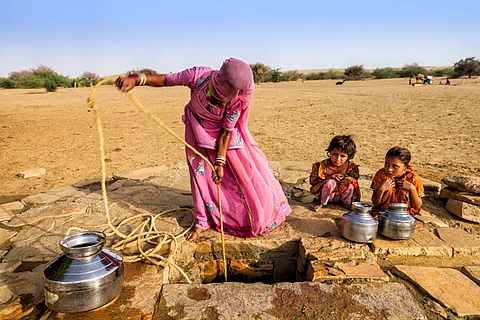

India faces a critical challenge as water supply shortages emerge as the most severe risk confronting the country over the next two years (2025–2027), the World Economic Forum (WEF) warned in a new report released on January 15, 2025.
The 20th edition of the WEF’s annual Global Risks Report identifies India alongside Mexico, Morocco, Tunisia, and Uzbekistan as the five countries where water supply crises rank as the top immediate or short-term risks.
The report highlights that water supply shortages, whether for human, industrial, or ecosystem needs, lead to water insecurity at local, regional, and global levels. These shortages are driven by factors including human overexploitation, mismanagement of critical natural resources, climate change, and insufficient infrastructure.
The number of countries identifying water supply shortages as a top-five risk has surged from seven in 2024 to 27 in 2025, reflecting the growing global crisis and the increasing significance of this issue. In North Africa, Morocco and Tunisia have seen water concerns rise from the third-most severe risk in 2024 to the foremost challenge in 2025.
The WEF report, released ahead of the flagship annual meeting in Davos, outlines some of the most critical risks the world may face over the next decade, set against the backdrop of a warming climate, conflicts, rapid technological advancements like Artificial Intelligence, and the spread of misinformation and disinformation. It also identifies the top five risks for each country based on a global survey. These country-specific risks are classified as short-term, referring to challenges expected to arise between 2025 and 2027.
The findings, based on a global survey, underscore the urgent need for India and other affected nations to address water scarcity through sustainable management strategies and policy interventions.
India’s risk profile, as outlined in the Global Risks Report 2025, highlights critical challenges across technological, societal, environmental, and economic domains. Alongside water supply shortages, four other risks—misinformation and disinformation (2nd), erosion of human rights and/or civic freedoms (3rd), pollution (4th), and labour and/or talent shortages (5th)—rank among the top risks India will confront between 2025 and 2027.
Pollution — spanning air, water, and soil — has emerged as another top immediate environmental risk for India.
Meanwhile, air pollution continues to pose a significant health and economic risk. For instance, polluted air is reducing the global average lifespan by almost 3.6 years, according to the most recent Air Quality Life Index released by the Energy Policy Institute at the University of Chicago (EPIC). It also impacts economic growth, according to the World Bank.
The report highlights the rising severity of pollution globally, with the number of countries identifying it among their top five risks increasing from six in 2024 to 13 in 2025. These include Bangladesh and Nepal in South Asia.
In Ghana and Mongolia, pollution ranks as the second-most severe environmental risk over the next two years in the global risk assessment. These risks, interconnected with climate change, are contributing to an increasingly fragile global ecosystem, warned the WEF.
Globally, extreme weather events are the second most severe risk the world is expected to face over the next two years. However, these do not figure among the top five immediate risks for India in the report for the second consecutive year.
Although not among the top five immediate risks for India, extreme weather events have become increasingly frequent, intense, and devastating, according to the Centre for Science and Environment’s most recent annual assessment of extreme weather events. These events occurred on 93 per cent of days from January to September 2024, compared to 86 per cent in 2022 and 88 per cent in 2023. The human and economic toll has also been severe, with 3,238 lives lost in 2024, marking an 18 per cent increase from 2022.
However, climate change is projected to exacerbate these events further in the coming years, warned the Intergovernmental Panel on Climate Change in its Sixth Assessment Report (AR6).